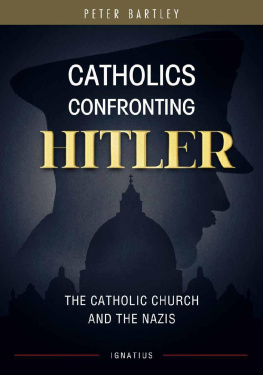
THE HIDDEN HISTORY OF THE NAZI RESISTANCE MOVEMENT 194445
About the Author
Perry Biddiscombe is Professor of History at the University of Victoria, British Columbia, Canada. He is the acknowledged world expert on the guerrilla forces of the Third Reich. His other books include The Last Nazis: SS Werewolf Guerrilla Resistance in Europe 19441947 and Werwolf!: The History of the National Socialist Guerrilla Movement 19441946, described by The Independent as the most complete history of the Nazi partisan movement. He lives in Victoria.

PRAISE FOR PERRY BIDDISCOMBE
Throws fresh light on the Third Reichs last days BBC HISTORY MAGAZINE
The book explores the background to the movement, its operations and its wholly negative legacy this type of terrorism is a nasty constant in the history of the German radical-right HISTORY TODAY
Detailed, meticulously researched and highly readable... a must for all interested in the end of the Second World War MILITARY ILLUSTRATED

THE HIDDEN HISTORY OF THE NAZI RESISTANCE MOVEMENT 194445
PERRY BIDDISCOMBE

First published 2006
The History Press
The Mill, Brimscombe Port
Stroud, Gloucestershire, GL5 2QG
www.thehistorypress.co.uk
This ebook edition first published in 2013
All rights reserved
Perry Biddiscombe, 2006, 2013
The right of Perry Biddiscombe to be identified as the Author of this work has been asserted in accordance with the Copyrights, Designs and Patents Act 1988.
This ebook is copyright material and must not be copied, reproduced, transferred, distributed, leased, licensed or publicly performed or used in any way except as specifically permitted in writing by the publishers, as allowed under the terms and conditions under which it was purchased or as strictly permitted by applicable copyright law. Any unauthorised distribution or use of this text may be a direct infringement of the authors and publishers rights, and those responsible may be liable in law accordingly.
EPUB ISBN 978 0 7524 9645 0
Original typesetting by The History Press
Contents
Acknowledgements
My recent researches have resulted in a series of fascinating correspondences and exchanges with scholars working in analogous areas, whom I want to acknowledge for providing their expertise and for stimulating my own thinking. Thanks to Paltin Sturdza, Michael Jung, and especially Jeff Burds, with whom I have exchanged much information and whose insights have proven invaluable in developing my understanding of the situation in Eastern Europe. Jeff is most kind in sharing knowledge and truly regards our discipline as a collaborative effort. Thanks as well to my colleague, Serhy Yekelchyk, who provided advice on Ukrainian sources, and to Eugne Martres, who helped me with literature on German parachutists in France.
A work of this scope it covers twenty-four different countries would not have been possible without the help of a number of specialists who provided me with access to literature in languages that are beyond my ken. In this regard, I especially want to thank Sonja Yli-Kahila and Chris Wojtan, who are former students of mine and graciously came to my aid. Sonja and Chris translated literature on resistance movements in Finland and Poland, and the depth of the sections of the book dealing with such matters owe directly to their contributions. My appreciation as well to Rachel Dekker, who helped me investigate rumours about Skorzenys possible connection with Prince Bernhardt of the Netherlands. For aid with letter-writing to various archives and libraries, thanks to Pasi Ahonen, Vanetta Petkova, Bogdan Verjinschi and Sharon Willis.
A special debt of gratitude is owed to the various archivists and librarians who have helped me over a long period of time. So thanks to the archivists at the National Archives II (College Park), the National Archives of the UK, the various offices and bureaux of the Bundesarchiv, the Archives Nationales, the National Archives of Canada, the Imperial War Museum and the Archivio Centrale dello Stato. Aila Narva at the Arkistolaitos in Helsinki kindly provided me with references to Finnish literature, and the staff at the Centre dtudes et de Documentation Guerre et Socits Contemporaines, in Brussels, gave me material on pro-German activists in Belgium. Thanks as well to the librarians at the Library of Congress, the Staatsbibliothek zu Berlin (especially the Zeitungsabteilung, Westhafen), the Bibliotheque Nationale, the Centre Pompidou, the British Library, the Robbins Library (London School of Economics), the German Historical Institute (London), and of course the McPherson Library, which is the intellectual centrepiece of my home institution, the University of Victoria. In particular, the librarians in the Interlibrary Loans section at McPherson Library deserve commendation for their hard work and diligence.
My publisher, Jonathan Reeve, kindly showed interest in a book of this scope and gave me considerable latitude. Certainly, I am grateful for his patience and good humour. Thanks as well to the production team at Tempus, who excel at their jobs. Their ability to format a book that is pleasing to the eye makes it much easier to present a historical narrative that is not a chore to read. And thanks to one of my departments secretaries, Eileen Zapshala, who helped me with technical issues involved in preparing the manuscript.
Finally, my sincere appreciation to my wife and son, who helped with research, proofread several chapters of the manuscript and have generally acted as a sounding board for my ideas and inspirations. Through thick and thin, they have always supported me.
Perry Biddiscombe, Victoria, BC
Introduction
Readers who crack the spine of this volume will find themselves through the looking glass. They will encounter a faltering Third Reich, around 19441945, that attempted to field partisans and freedom fighters against its enemies, promising to liberate Europe from the very powers that were themselves delivering the continent from tyranny. Such efforts revolved around the central figure of Otto Skorzeny, the notorious German commando chief and rescuer of Benito Mussolini who created a network of special units which functioned at the intersection between military force and politics.
Although Skorzeny prided himself a simple man, his was a house of many mansions. The centre of his network was a series of SS battalions called Jagdverbnde, or hunter formations, which were assigned the job of leading a guerrilla war behind the lines of the advancing Allied and Soviet armies. This volume, however, also chronicles the story of a closely related body called Section S, which trained saboteurs and terrorists, and it provides an account of AbwehrFrontaufklrung (front reconnaissance, FAK) detachments, some of which specialised in sabotage and bore responsibilities that overlapped those of the SS-Jagdverbnde. All three types of units were controlled by Skorzeny, at least loosely, and he planned to amalgamate them into a coherent whole. A clear recognition of the nature and function of these organisations will help us understand the legacy of their chief, perhaps in a different sense than he himself might have wanted.
Next page








